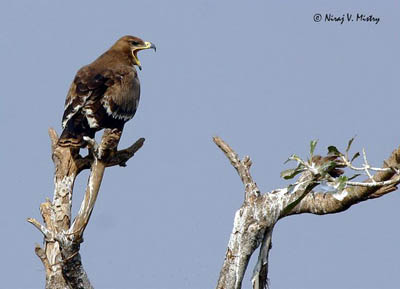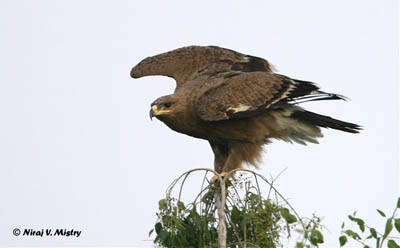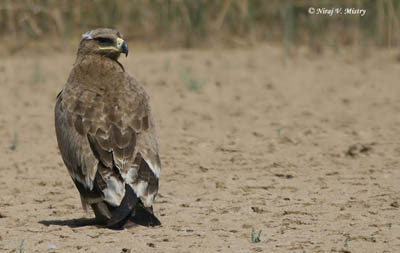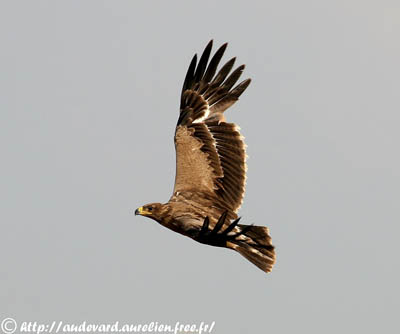
Steppe Eagle
Aquila nipalensis
Accipitriforme Order – Accipitridae Family
BIOMETRICS:
Length: 72-81 cm
Wingspan: 160-200 cm
Weight: 2400-3900 g
LONGEVITY: Up to 41 years in captivity
DESCRIPTION:
Steppe Eagle adult has dark brown plumage overall. The body is darker than the greyish wings. Flight and tail feathers are greyish, and may be barred dark grey.
Fr : Aigle des steppes
All : Steppenadler
Esp : Águila Esteparia
Ital : Aquila delle steppe
Nd : Steppearend
Russe : Степняк
Sd: Stäppörn
Photographers:
Niraj V. Mistry
Photo Galleries
Aurélien Audevard
OUESSANT DIGISCOPING
Text by Nicole Bouglouan
Sources :
HANDBOOK OF THE BIRDS OF THE WORLD Vol 2 by Josep del Hoyo-Andrew Elliot-Jordi Sargatal - Lynx Edicions - ISBN: 8487334156
GUIDE DES RAPACES DIURNES – Europe, Afrique du Nord et Moyen-Orient de Benny Génsbol – Delachaux et Niestlé – ISBN : 2603013270
Wikipedia (Wikipedia, The Free Encyclopedia)
Steppe Eagle resembles several other eagles’ species, but the main features are the rufous patches visible on nape and neck of adults, and the large gape.
Numerous eagles show pale rump and white patch on back.
When flying, we can see a whitish patch on the hand, and some eagles have pale inner webs on most of the primary feathers.
The strong, hooked bill is dark grey with yellow cere and long gape. Nostrils are oval. Eyes are brown. Short legs are feathered brown. Talons are yellow.
Female is similar in plumage, but larger than male.
Juvenile eagle and immature often show broad white band along the greater coverts on the underwing. Plumage is paler.
The young Steppe Eagle reaches the adult plumage at 4-5 years.
We find two subspecies:
A.n. nipalensis
A.n. orientalis, slightly smaller and paler.

VOICE: SOUNDS BY XENO-CANTO
Steppe Eagle is usually silent outside breeding season, but when displaying, it utters crow-like barking. Calls are often given during some behaviour such as displays, contact, alarm and threat.
HABITAT:
Steppe Eagle frequents grassy steppes and semi-desert.
The subspecies “nipalensis” is found in mountainous areas during the breeding season, up to 2300 metres of elevation, whereas the race “orientalis” breeds in lowlands.
RANGE:
Steppe Eagle breeds from Romania, through the Asiatic steppes to Mongolia.
They are migratory raptors. The European and Central Asian races winter in Africa, whereas the eastern races winter in India.

BEHAVIOUR:
Steppe Eagle feeds almost exclusively on several races of susliks, and especially Little Suslik (Citellus pygmaeus), small rodent related to terrestrial squirrels.
It also may take other small rodents and young terrestrial birds, and occasionally crickets and reptiles.
Steppe Eagle hunts from a hide and often pursues the prey before to catch it. This eagle may hunt by walking, or while flying, by circling and diving. It also waits at burrow entrance for rodents. It captures the preys with the talons.

Steppe Eagle arrives in March at breeding areas. Both mates often arrive together.
In this species, breeding season is strongly dependent on preys’ availability.
They are migratory birds, leaving the breeding areas in late August for their wintering territories.
FLIGHT:
Steppe Eagle has long, broad wings, and flies with heavy, slow wing beats. When circling, the wings are held horizontally with slightly hanging hand. When soaring, wings are raised and bent at hand level.

REPRODUCTION:
Breeding season occurs from April to July.
The nest is usually on the ground, with good view of the surroundings, but this species now, often nests on bushes or small trees, a few metres above the ground.
The nest is a large platform made with sticks, and the cup is lined with materials such as twigs, rags, bones, feathers and camel dung. But the lining depends on the availability of nest materials.
Female lays 1-3 eggs. Incubation lasts about 45 days.
Chicks are covered with white down at hatching, turning greyer later.
They fledge about 55 to 65 days after hatching.
Breeding success depends on the susliks’ availability.
DIET:
Steppe Eagle uses wide variety of hunting techniques, and may catch preys by walking or flying. It often steals preys from other raptors when in flight.
Susliks are their favourite preys, but other rodents, terrestrial birds, reptiles and crickets are also taken. Carrion is eaten during migration and on wintering areas, mainly by immature birds.
PROTECTION / THREATS / STATUS:
Steppe Eagle is vulnerable to persecution, changes or destruction of their habitat for agriculture, and collision with power lines.
This species may be common in suitable habitat, and it is one of the most common eagles in the world.
Steppe Eagle is not threatened at this moment.